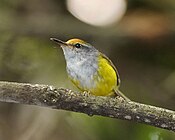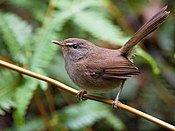Old World warblers are a large group of birds formerly grouped together in the bird family Sylviidae. They are not closely related to the New World warblers. The family held over 400 species in over 70 genera, and were the source of much taxonomic confusion. Two families were split out initially, the cisticolas into Cisticolidae and the kinglets into Regulidae. In the past ten years they have been the subject of much research and many species are now placed into other families, including the Acrocephalidae, Cettiidae, Phylloscopidae, and Megaluridae. In addition some species have been moved into existing families or have not yet had their placement fully resolved. A smaller number of warblers, together with some babblers formerly placed in the family Timaliidae and the parrotbills, are retained in a much smaller family Sylviidae.

The typical warblers are small birds belonging to the genus Sylvia in the "Old World warbler" family Sylviidae.

The family Cisticolidae is a group of about 160 warblers, small passerine birds found mainly in warmer southern regions of the Old World. They were formerly included within the Old World warbler family Sylviidae.

Bush-warblers are small insectivorous songbirds of the genera Cettia, Horornis, and Bradypterus. They were formerly placed in the "wastebin" Old World warbler family. None of the genera as traditionally delimited are believed to be monophyletic.

Cettia is a genus of small insectivorous songbirds ("warblers") which make up the core of the newly recognized family Cettiidae. They were formerly placed in the Sylviidae, which at that time was a wastebin taxon for the warbler-like Sylvioidea. The range of this genus extends from Europe to southeast Asia.

Tailorbirds are small birds, most belonging to the genus Orthotomus. While they were often placed in the Old World warbler family Sylviidae, recent research suggests they more likely belong in the Cisticolidae and they are treated as such in Del Hoyo et al. One former species, the mountain tailorbird, is actually closer to an old world warbler genus Cettia.

Neumann's warbler, also known as Neumann's short-tailed warbler, is a species of bird in the family Cettiidae. It is found in Democratic Republic of the Congo, Rwanda, and Uganda. Its natural habitat is subtropical or tropical moist montane forest.

Hemitesia is a genus of Old World warblers in the family Cettiidae, formerly classified in the family Sylviidae. The genus was erected by James Chapin in 1948.

The green hylia is a monotypic genus widespread in tropical Africa, where it mostly inhabits the understory and mid-stratum of moist forest. It is a canopy insectivore which had been tentatively placed within the family of Cettiidae warblers, but in 2019 its assignment to a new family, the Hyliidae, was strongly supported.

The chestnut-headed tesia is a small insectivorous songbird formerly of the "Old World warbler" family but nowadays placed in the bush warbler family (Cettiidae).

The tesias are a genus, Tesia, of Old World warbler. Though once included in the large family Sylviidae, more recent research placed it within a new family, Cettiidae. The four species inhabit undergrowth of montane forest in South and Southeast Asia, where they are resident or short-range migrants. They have longish legs and appear tailless, with (seemingly) only 8 rectrices. Their simple songs are fairly loud, and their nests are typically ball-shaped. Their name is derived from Tisi, the Nepalese name for the grey-bellied tesia.

The Bornean stubtail is a species of bird in the cettiid warbler family Cettiidae. It is endemic to the island of Borneo, where it inhabits forest floors and undergrowth in montane forests at elevations of 750–3,150 m (2,460–10,330 ft). It is a small, short-tailed warbler, measuring 9.5–10 cm (3.7–3.9 in) in length and having an average mass of 10.4 g (0.37 oz). The tops of the head and the upperparts are brown, with whitish underparts that turn grey at the sides of the breast and the flanks. The supercilium is long and buffish-brown, with an equally long dark grey eyestripe and a thin yellow eye-ring. Both sexes are similar.

Locustellidae is a newly recognized family of small insectivorous songbirds ("warblers"), formerly placed in the Old World warbler "wastebin" family. It contains the grass warblers, grassbirds, and the Bradypterus "bush warblers". These birds occur mainly in Eurasia, Africa, and the Australian region. The family name is sometimes given as Megaluridae, but Locustellidae has priority.

Pnoepyga is a genus of passerines endemic to southern and southeastern Asia. Its members are known as cupwings or wren-babblers. The genus contains four species. The genus has long been placed in the babbler family Timaliidae. A 2009 study of the DNA of the families Timaliidae and the Old World warblers (Sylviidae) found no support for the placement of the genus in either family, prompting the authors to erect a new monogeneric family, the Pnoepygidae.

Sylvioidea is a superfamily of passerine birds, one of at least three major clades within the Passerida along with the Muscicapoidea and Passeroidea. It contains about 1300 species including the Old World warblers, Old World babblers, swallows, larks and bulbuls. Members of the clade are found worldwide, but fewer species are present in the Americas.

The African warblers are a newly erected family Macrosphenidae, of African songbirds. Most of the species were formerly placed in the Old World warbler family Sylviidae, although one species, the rockrunner, was placed in the babbler family, Timaliidae. A series of molecular studies of the Old World warblers and other bird families in the superfamily Sylvioidea found that the African warblers were not part of Sylviidae but were instead an early (basal) offshoot of the entire clade Sylvioidea. Some taxonomic authorities place the entire family Hyliidae here.

Horornis is a genus of small insectivorous songbirds ("warblers") which make up the core of the newly recognized family Cettiidae. They were formerly placed in the Sylviidae, which at that time was a wastebin taxon for the warbler-like Sylvioidea. The range of this genus occurs from southeast Asia throughout the western Pacific. The most recently described species is the Bougainville bush warbler from Bougainville Island.

The species of tailorbirds listed below are small birds of the genus Phyllergates . They were previously placed in the Old World warbler family Sylviidae. However, recent research suggests they more likely belong in the Cettiidae.

The jungle babblers are a family, Pellorneidae, of mostly Old World passerine birds belonging to the superfamily Sylvioidea. They are quite diverse in size and coloration, and usually characterised by soft, fluffy plumage and a tail on average the length of their body, or longer. These birds are found in tropical zones, with the greatest biodiversity in Southeast Asia and the Indian subcontinent.

Hyliidae is a family of passerine birds which contains just two species, the green hylia and the tit hylia. Physiological similarities and molecular phylogenetic studies strongly support the creation of this family.
























